D-Link DI-524 User Manual

D-Link AirPlus GTM
DI-524
802.11g/2.4GHz
Wireless Router
Manual
Building Networks for People
Contents
Package Contents................................................................................ |
3 |
Introduction........................................................................................... |
4 |
Wireless Basics.................................................................................... |
8 |
Getting Started .................................................................................... |
11 |
Using the Configuration Menu............................................................ |
12 |
Networking Basics.............................................................................. |
39 |
Troubleshooting.................................................................................. |
54 |
Technical Specifications ..................................................................... |
61 |
Frequently Asked Questions .............................................................. |
64 |
Contacting Technical Support............................................................. |
92 |
Warranty and Registration.................................................................. |
93 |
2
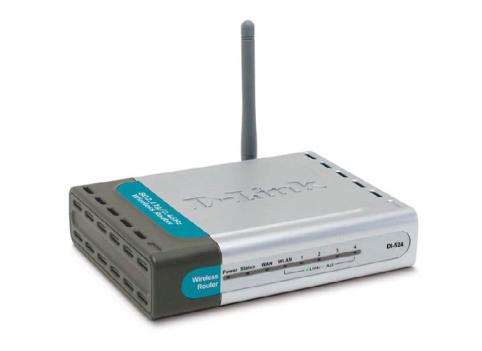
Package Contents
Contents of Package:
D-Link AirPlus G DI-524
802.11g/2.4GHz Wireless Router Power Adapter-DC 5V, 2.5A
Manual and Warranty on CD
Quick Installation Guide
Ethernet Cable (All the DI-524’s Ethernet ports are Auto-MDIX)
Note: Using a power supply with a different voltage rating than the one included with the DI-524 will cause damage and void the warranty for this product.
If any of the above items are missing, please contact your reseller.
System Requirements for Configuration:
Ethernet-Based Cable or DSL Modem
Computers with Windows, Macintosh, or Linux-based operating systems with an installed Ethernet adapter
Internet Explorer Version 6.0 or Netscape Navigator Version 6.0 and Above
3
Introduction
The D-Link AirPlus G DI-524 802.11g/2.4 Ghz Wireless Router is an 802.11g highperformance, wireless router that supports high-speed wireless networking at home, at work or in public places.
Unlike most routers, the DI-524 provides data transfers at up to 54 Mbps* (compared to the standard 11 Mbps) when used with other D-Link AirPlus G products. The 802.11g standard is backwards compatible with 802.11b products. This means that you do not need to change your entire network to maintain connectivity. You may sacrifice some of 802.11g’s speed when you mix 802.11b and 802.11g devices, but you will not lose the ability to communicate when you incorporate the 802.11g standard into your 802.11b network. You may choose to slowly change your network by gradually replacing the
802.11b devices with 802.11g devices .
In addition to offering faster data transfer speeds when used with other 802.11g products, the DI-524 has the newest, strongest, most advanced security features available today. When used with other 802.11g WPA (WiFi Protected Access) and 802.1x compatible products in a network with a RADIUS server, the security features include:
WPA: Wi-Fi ProtectedAccess authorizes and identifies users based on a secret key that changes automatically at a regular interval. WPA uses TKIP (Temporal Key Integrity Protocol) to change the temporal key every 10,000 packets (a packet is a kind of message transmitted over a network.) This insures much greater security than the standard WEP security. (By contrast, the older WEP encryption required the keys to be changed manually.)
802.1x: Authentication is a first line of defense against intrusion. In theAuthentication process the server verifies the identity of the client attempting to connect to the network. Unfamiliar clients would be denied access.
For home users that will not incorporate a RADIUS server in their network, the security for the DI-524, used in conjunction with other 802.11g products, will still be much stronger than ever before. Utilizing the Pre Shared Key mode of WPA, the DI-524 will obtain a new security key every time it connects to the 802.11g network. You only need to input your encryption information once in the configuration menu. No longer will you have to manually input a new WEP key frequently to ensure security, with the DI-524, you will automatically receive a new key every time you connect, vastly increasing the safety of your communications.
*Maximum wireless signal rate based on IEEE Standard 802.11g specifications. Actual data throughput will vary. Network conditions and environmental factors, including volume of network traffic, building materials and construction, and network overhead lower actual data throughput rate.
4
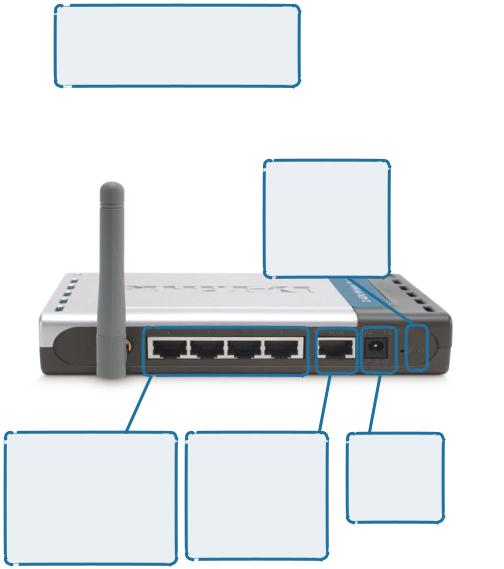
Connections
All Ethernet Ports (WAN and LAN) are auto MDI/MDIX, meaning you can use either a straight-through or a crossover Ethernet cable.
Pressing the
Reset Button restores the router to its original factory default settings.
Auto MDI/MDIX LAN ports automatically sense the cable type when connecting to Ethernet-enabled computers.
The Auto MDI/ MDIX WAN port is the connection for the Ethernet cable to the Cable or DSL modem.
Receptor for the
Power
Adapter.
5

LEDs
WAN LED A solid light indicates connection on the WAN port. This LED blinks during data transmission.
WLAN LED A solid light indicates that the wireless segment is ready. This LED blinks during wireless data transmission.
POWER LED A solid light indicates a proper connection to the power supply.
STATUS A blinking light indicates that the DI-524 is ready.
LOCAL NETWORK LED A solid light indicates a connection to an Ethernet-en- abled computer on ports 1-4. This LED blinks during data transmission.
6
Features
Fully compatible with the 802.11g standard to provide a wireless data rate of up to 54Mbps.*
Backwards compatible with the 802.11b standard to provide a wireless data rate of up to 11Mbps.
WPA (Wi Fi Protected Access) authorizes and identifies users based on a secret key that changes automatically at a regular interval, for example:
TKIP (Temporal Key Integrity Protocol), in conjunction with a RADIUS server, changes the temporal key every 10,000 packets, ensuring greater security.
Pre Shared Key mode means that the home user, without a RADIUS server, can connect securely via a pre-shared key, vastly improving the safety of communications on the network.
802.1x Authentication in conjunction with the RADIUS server verifies the identity of would be clients.
Utilizes OFDM technology (Orthogonal Frequency Division Multiplexing).
User-friendly configuration and diagnostic utilities.
Operates in the 2.4GHz frequency range.
Connects multiple computers to a Broadband (Cable or DSL) modem to share the Internet connection.
Advanced Firewall features
Supports NAT with VPN pass-through, providing added security
MAC Filtering
IP Filtering
URL Filtering
Domain Blocking
Scheduling
DHCP server enables all networked computers to automatically receive IP addresses.
Web-based interface for Managing and Configuring.
Access Control to manage users on the network.
Supports special applications that require multiple connections.
Equipped with 4 10/100 Ethernet ports, 1 WAN port, Auto MDI/MDIX.
*Maximum wireless signal rate based on IEEE Standard 802.11g specifications. Actual data throughput will vary. Network conditions and environmental factors, including volume of network traffic, building materials and construction, and network overhead lower actual data throughput rate. 7
Wireless Basics
D-Link wireless products are based on industry standards to provide easy-to-use and compatible high-speed wireless connectivity within your home, business or public access wireless networks. D-Link wireless products will allow you access to the data you want, when and where you want it. You will be able to enjoy the freedom that wireless networking brings.
AWLAN is a cellular computer network that transmits and receives data with radio signals instead of wires. WLANs are used increasingly in both home and office environments, and public areas such as airports, coffee shops and universities. Innovative ways to utilize WLAN technology are helping people to work and communicate more efficiently. Increased mobility and the absence of cabling and other fixed infrastructure have proven
to be beneficial for many users.
Wireless users can use the same applications they use on a wired network. Wireless adapter cards used on laptop and desktop systems support the same protocols as Ethernet adapter cards.
People use wireless LAN technology for many different purposes:
Mobility - Productivity increases when people have access to data in any location within the operating range of the WLAN. Management decisions based on real-time information can significantly improve worker efficiency.
Low Implementation Costs – WLANs are easy to set up, manage, change and relocate. Networks that frequently change can benefit from WLANs ease of implementation. WLANs can operate in locations where installation of wiring may be impractical.
Installation and Network Expansion - Installing a WLAN system can be fast and easy and can eliminate the need to pull cable through walls and ceilings. Wireless technology allows the network to go where wires cannot go - even outside the home or office.
Scalability – WLANs can be configured in a variety of topologies to meet the needs of specific applications and installations. Configurations are easily changed and range from peer-to-peer networks suitable for a small number of users to larger infrastructure networks to accommodate hundreds or thousands of users, depending on the number
of wireless devices deployed.
Inexpensive Solution - Wireless network devices are as competitively priced as conventional Ethernet network devices.
8
Wireless Basics (continued)
Standards-Based Technology
The DI-524 Wireless Broadband Router utilizes the new 802.11g standard.
The IEEE 802.11g standard is an extension of the 802.11b standard. It increases the data rate up to 54 Mbps* within the 2.4GHz band, utilizing OFDM technology.
This means that in most environments, within the specified range of this device, you will be able to transfer large files quickly or even watch a movie in MPEG format over your network without noticeable delays. This technology works by transmitting highspeed digital data over a radio wave utilizing OFDM (Orthogonal Frequency Division Multiplexing) technology. OFDM works by splitting the radio signal into multiple smaller sub-signals that are then transmitted simultaneously at different frequencies to the receiver. OFDM reduces the amount of crosstalk (interference) in signal transmissions.
The DI-524 is backwards compatible with 802.11b devices. This means that if you have an existing 802.11b network, the devices in that network will be compatible with 802.11g devices at speeds of up to 11Mbps in the 2.4GHz range.
*Maximum wireless signal rate based on IEEE Standard 802.11g specifications. Actual data throughput will vary. Network conditions and environmental factors, including volume of network traffic, building materials and construction, and network overhead lower actual data throughput rate.
9
Wireless Basics (continued)
Installation Considerations
The D-Link AirPlus G DI-524 lets you access your network, using a wireless connection, from virtually anywhere within its operating range. Keep in mind, however, that the number, thickness and location of walls, ceilings, or other objects that the wireless signals must pass through, may limit the range. Typical ranges vary depending on the types of materials and background RF (radio frequency) noise in your home or business. The key to maximizing wireless range is to follow these basic guidelines:
1Keep the number of walls and ceilings between the DI-524 and other network devices to a minimum - each wall or ceiling can reduce your D-Link wireless product’s range from 3-90 feet (1-30 meters). Position your devices so that the number of walls or ceilings is minimized.
2Be aware of the direct line between network devices. A wall that is 1.5 feet thick (.5 meters), at a 45-degree angle appears to be almost 3 feet (1 meter) thick. At a 2-degree angle it looks over 42 feet (14 meters) thick! Position devices so that the signal will travel straight through a wall or ceiling (instead of at an angle) for better reception.
3Building Materials can impede the wireless signal - a solid metal door or aluminum studs may have a negative effect on range. Try to position wireless devices and computers with wireless adapters so that the signal passes through drywall or open doorways and not other materials.
4Keep your product away (at least 3-6 feet or 1-2 meters) from electrical devices or appliances that generate extreme RF noise.
10
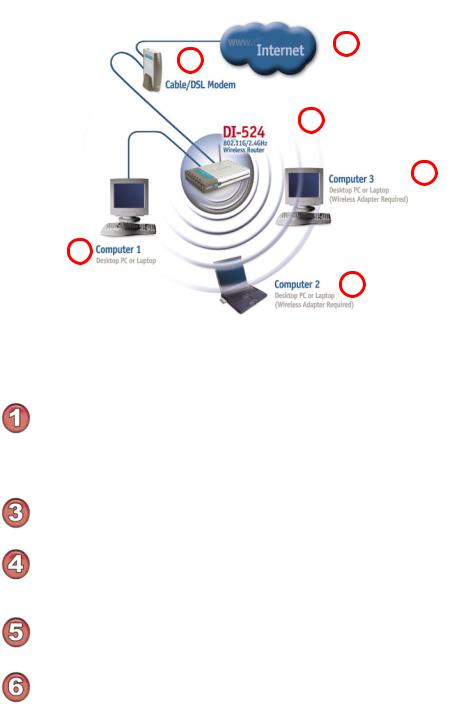
Getting Started |
|
||
Setting up |
|
1 |
|
a Wireless |
2 |
||
|
|||
Infrastructure |
|
||
|
|
||
Network |
|
|
|
3
4
6
5
Please remember that D-Link AirPlus G wireless devices are pre-configured to connect together, right out of the box, with their default settings.
For a typical wireless setup at home (as shown above), please do the following:
You will need broadband Internet access (a Cable or DSL-subscriber line into your home or office).
 Consult with your Cable or DSL provider for proper installation of the modem.
Consult with your Cable or DSL provider for proper installation of the modem.
Connect the Cable or DSL modem to the DI-524 Wireless Broadband Router (see the printed Quick Installation Guide included with your router).
If you are connecting a desktop computer to your network, install the D-Link AirPlus G DWL-G510 wireless PCI adapter into an available PCI slot on your desktop computer. You may also install the DWL-G520, or the DWL-520.
(See the printed Quick Installation Guide included with the network adapter.)
Install the D-Link DWL-G630 wireless Cardbus adapter into a laptop computer. (See the printed Quick Installation Guide included with the DWL-G630.)
Install the D-Link DFE-530TX+ adapter into a desktop computer. The four Ethernet LAN ports of the DI-524 are Auto MDI/MDIX and will work with both Straight-Through and Cross-Over cable.
(See the printed Quick Installation Guide included with the DFE-530TX+.)11
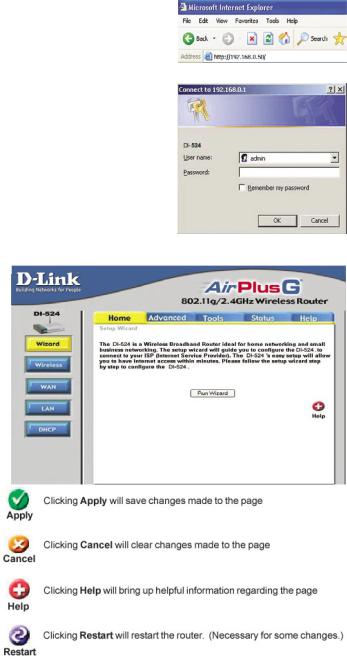
Using the Configuration Menu
Whenever you want to configure your network or the DI-524, you can access the Configuration Menu by opening the web-browser and typing in the IP Address of the DI-524. The DI-524 default IP Address
is shown at right:
Open the web browser
Type in the IP Address of the Router (http://192.168.0.1)
Note: if you have changed the default IP Address assigned to the DI-524, make sure to enter the correct IP Address.
Type admin in the User Name field
Leave the Password blank
Click OK Home > Wizard
The Home>Wizard screen will appear. Please refer to the
Quick Installation Guidefor more information regarding the Setup Wizard.
These buttons appear on most of the configuration screens in this section. Please click on the appropriate button at the bottom of each screen after you have made a configuration change.
.
.
.
12
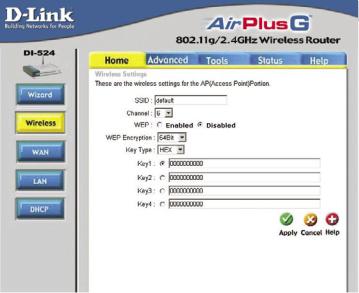
Using the Configuration Menu (continued)
Home > Wireless
SSID-
Channel-
WEP-
WEP Encryption-
Key Type-
Keys 1-4-
Service Set Identifier (SSID) is the name designated for a specific wireless local area network (WLAN). The SSID’s factory default setting is default. The SSID can be easily changed to connect to an existing wireless network or to establish a new wireless network.
6 is the default channel. All devices on the network must share the same channel. (Note: The wireless adapters will automatically scan and match the wireless setting.)
Wired Equivalent Privacy (WEP) is a wireless security protocol for Wireless Local Area Networks (WLAN). WEP provides security by encrypting the data that is sent over the WLAN. Select
Enabled or Disabled. Disabled is the default setting. (Note: If you enable encryption on the DI-524 make sure to also enable encryption on all the wireless clients or wireless connection will not be established.)
Select the level of encryption desired: 64-bit, or 128-bit.
Select HEX or ASCII.
Input up to 4 WEP keys; select the one you wish to use.
13

Using the Configuration Menu (continued)
Home > WAN > Dynamic IP Address
Dynamic
IP Address-
Host Name-
MAC Address-
Clone
MAC Address-
Choose Dynamic IP Address to obtain IP Address information automatically from your ISP. Select this option if your ISP does not give you any IP numbers to use. This option is commonly used for Cable modem services.
The Host Name is optional but may be required by some ISPs. The default host name is the device name of the Router and may be changed.
The default MACAddress is set to the WAN’s physical interface MAC address on the Broadband Router. It is not recommended that you change the default MAC address unless required by your ISP.
The default MAC address is set to the WAN’s physical interface MAC address on the Broadband Router.You can use the “Clone MACAddress” button to copy the MAC address of the Ethernet Card installed by your ISP and replace the WAN MAC address with the MAC address of the router. It is not recommended that you change the default MAC address unless required by your ISP.
14
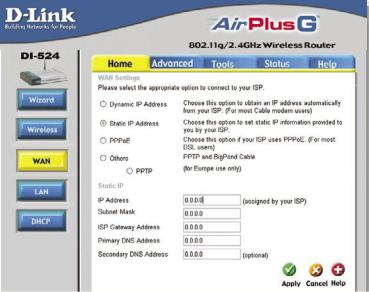
Using the Configuration Menu (continued)
Home > WAN > Static IP Address
Static IP Address-
IP Address-
Subnet Mask-
Choose Static IPAddress if all WAN IP information is provided to you by your ISP. You will need to enter in the IP address, subnet mask, gateway address, and DNS address(es) provided to you by your ISP. Each IP address entered in the fields must be in the appropriate IP form, which are four octets separated by a dot (x.x.x.x). The Router will not accept the IP address if it is not in this format.
Input the public IP Address provided by your ISP.
Input your Subnet mask. (All devices in the network must have the same subnet mask.)
ISP
Gateway Address-
Primary
DNS Address-
Secondary
DNS Address-
Input the public IP address of the ISP to which you are connecting.
Input the primary DNS (Domain Name Server) IP address provided by your ISP.
This is optional.
15

Using the Configuration Menu (continued)
Home > WAN > PPPoE
Please be sure to remove any existing PPPoE client software
installed on your com-
puters.
Choose PPPoE (Point to Point Protocol over Ethernet) if your ISP uses a PPPoE connection. Your ISP will provide you with a username and password. This option is typically used for DSL services. Select Dynamic PPPoE to obtain an IP address automatically for your PPPoE connection. Select Static PPPoE to use a static IP address for your PPPoE connection.
PPPoE- |
Choose this option if your ISP uses PPPoE. (Most DSL users |
|
will select this option.) |
|
Dynamic PPPoE- receive an IPAddress automatically from your ISP. |
|
Static PPPoE-you have an assigned (static) IP Address. |
User Name- |
Your PPPoE username provided by your ISP. |
Retype Password- Re-enter the PPPoE password
Service Name- |
Enter the Service Name provided by your ISP (optional). |
IP Address- |
This option is only available for Static PPPoE. Enter the static |
|
IP Address for the PPPoE connection. |
Primary DNS |
Primary DNS IP address provided by our ISP |
Address- |
|
Secondary DNS |
This option is only available for Static PPPoE. Enter the static |
Address- |
IP Address for the PPPoE connection. |
(Continued on the next page) |
16 |
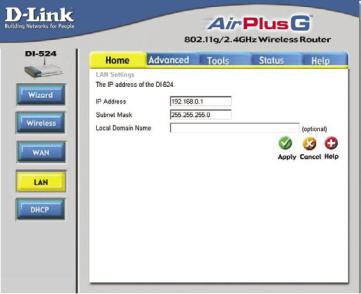
Using the Configuration Menu (continued)
Home > WAN > PPPoE continued
Maximum |
Enter a maximum idle time during which Internet connection |
Idle Time- |
is maintained during inactivity. To disable this feature, enable |
|
Auto-reconnect. |
MTU-
Auto-reconnect-
Maximum Transmission Unit-1492 is the default setting-you may need to change the MTU for optimal performance with your specific ISP.
If enabled, the DI-524 will automatically connect to your ISP after your system is restarted or if the PPPoE connection is dropped.
Home > LAN
LAN is short for LocalArea Network. This is considered your internal network. These are the IP settings of the LAN interface for the DI-524. These settings may be referred to as Private settings. You may change the LAN IP address if needed. The LAN IP address is private to your internal network and cannot be seen on the Internet.
IP Address- |
The IP address of the LAN interface. The default IP address |
|
is: 192.168.0.1. |
Subnet Mask- |
The subnet mask of the LAN interface. |
|
The default subnet mask is 255.255.255.0. |
Local Domain- |
This field is optional. Enter in the local domain name. |
17
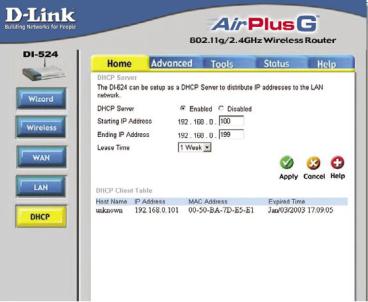
Using the Configuration Menu (continued)
Home > DHCP
DHCP stands for Dynamic Host Control Protocol. The DI-524 has a built-in DHCP server. The DHCP Server will automatically assign an IP address to the computers on the LAN/private network. Be sure to set your computers to be DHCP clients by setting their TCP/IP settings to “Obtain an IP Address Automatically.” When you turn your computers on, they will automatically load the proper TCP/IP settings provided by the DI-524. The DHCP Server will automatically allocate an unused IP address from the IP address pool to the requesting computer. You must specify the starting and ending
address of the IP address pool.
DHCP Server- |
Select Enabled or Disabled. The default setting is Enabled. |
Starting |
The starting IP address for the DHCP server’s IP assignment. |
IP Address- |
|
Ending |
The ending IP address for the DHCP server’s IP assignment. |
IP Address- |
|
Lease Time- |
The length of time for the IP address lease. Enter the Lease |
|
time. The default setting is one hour. |
18
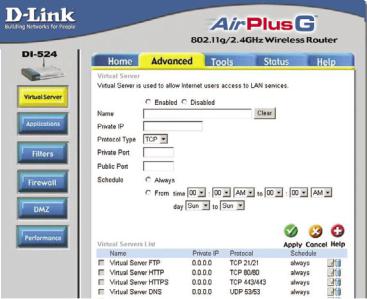
Using the Configuration Menu (continued)
Advanced > Virtual Server
The DI-524 can be configured as a virtual server so that remote users accessing Web or FTP services via the public IP address can be automatically redirected to local servers in the LAN (Local Area Network).
The DI-524 firewall feature filters out unrecognized packets to protect your LAN network so all computers networked with the DI-524 are invisible to the outside world. If you wish, you can make some of the LAN computers accessible from the Internet by enabling Virtual Server. Depending on the requested service, the DI-524 redirects
the external service request to the appropriate server within the LAN network.
The DI-524 is also capable of port-redirection meaning incoming traffic to a particular port may be redirected to a different port on the server computer.
Each virtual service that is created will be listed at the bottom of the screen in the Virtual Servers List. There are pre-defined virtual services already in the table. You may use them by enabling them and assigning the server IP to use that particular
virtual service.
19
Using the Configuration Menu (continued)
Advanced > Virtual Server continued
Virtual Server- |
Select Enabled or Disabled. |
Name- |
Enter the name referencing the virtual service. |
Private IP- |
The server computer in the LAN (Local Area Network) that will |
|
be providing the virtual services. |
Protocol Type- |
The protocol used for the virtual service. |
Private Port- |
The port number of the service used by the Private IP computer. |
Public Port- |
The port number on the WAN (Wide Area Network) side that |
|
will be used to access the virtual service. |
Schedule- |
The schedule of time when the virtual service will be enabled. |
|
The schedule may be set to Always, which will allow the |
|
particular service to always be enabled. If it is set to Time, |
|
select the time frame for the service to be enabled. If the |
|
system time is outside of the scheduled time, the service will |
|
be disabled. |
Example #1: If you have a Web server that you wanted Internet users to access at all times, you would need to enable it. Web (HTTP) server is on LAN (Local Area Network) computer 192.168.0.25. HTTP uses port 80, TCP.
Name: Web Server Private IP: 192.168.0.25 Protocol Type: TCP Private Port: 80
Public Port: 80 Schedule: always
20

Using the Configuration Menu (continued)
Advanced > Virtual Server continued
Click on this icon to edit the virtual service
Click on this icon to delete the virtual service
Example #2:
If you have an FTP server that you wanted Internet users to access by WAN port 2100 and only during the weekends, you would need to enable it as such. FTP server is on LAN computer 192.168.0.30. FTP uses port 21, TCP.
Name: FTP Server
Private IP: 192.168.0.30
Protocol Type: TCP
Private Port: 21
Public Port: 2100
Schedule: From: 01:00AM to 01:00AM, Sat to Sun
All Internet users who want to access this FTP Server must connect to it from port 2100. This is an example of port redirection and can be useful in cases where there are many of the same servers on the LAN network.
21
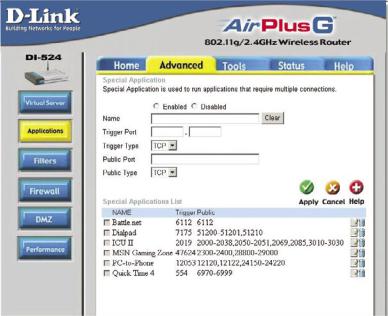
Using the Configuration Menu (continued)
Advanced > Applications
Some applications require multiple connections, such as Internet gaming, video conferencing, Internet telephony and others.These applications have difficulties working through NAT (NetworkAddress Translation). SpecialApplications makes some of these applications work with the DI-524. If you need to run applications that require multiple connections, specify the port normally associated with an application in the “Trigger Port” field, select the protocol type as TCP or UDP, then enter the public ports associated with the trigger port to open them for inbound traffic.
The DI-524 provides some predefined applications in the table on the bottom of the web page. Select the application you want to use and enable it.
Note! Only one PC can use each Special Application tunnel.
Name-
Trigger Port-
Trigger Type-
Public Port-
This is the name referencing the special application.
This is the port used to trigger the application. It can be either a single port or a range of ports.
This is the protocol used to trigger the special application.
This is the port number on the WAN side that will be used to access the application. You may define a single port or a range of ports. You can use a comma to add multiple ports or port ranges.
Public Type- |
This is the protocol used for the special application. |
22
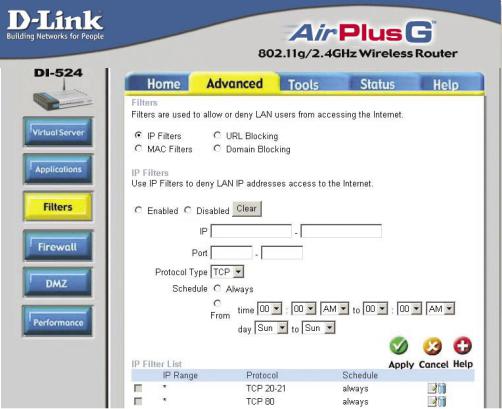
Using the Configuration Menu (continued)
Advanced > Filters > IP Filters
Filters are used to deny or allow LAN (Local Area Network) computers from accessing the Internet. The DI-524 can be setup to deny internal computers by their IP or MAC addresses. The DI-524 can also block users from accessing restricted web sites.
IP Filters- |
Use IP Filters to deny LAN IP addresses from accessing the |
|
Internet. You can deny specific port numbers or all ports for |
|
the specific IP address. |
IP- |
The IP address of the LAN computer that will be denied |
|
access to the Internet. |
Port- |
The single port or port range that will be denied access to the |
|
Internet. |
Protocol Type- |
Select the protocol type. |
Schedule- |
This is the schedule of time when the IP Filter will be enabled. |
23
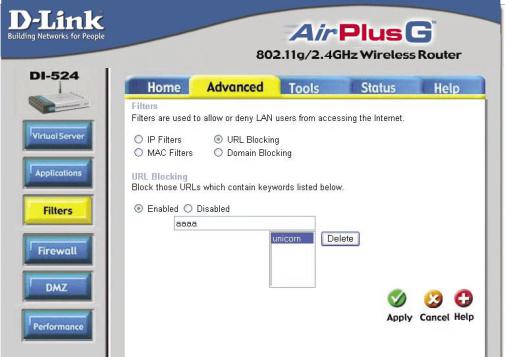
Using the Configuration Menu (continued)
Advanced > Filters > URL Blocking
URL Blocking is used to deny LAN computers from accessing specific web sites by the URL. A URL is a specially formatted text string that defines a location on the Internet. If any part of the URL contains the blocked word, the site will not be accessible and the web page will not display. To use this feature, enter the text string to be blocked and click Apply. The text to be blocked will appear in the list. To delete the text, just
highlight it and click Delete.
Filters- |
Select the filter you wish to use; in this case, URL Blocking |
|
was chosen. |
URL Blocking- |
Select Enabled or Disabled. |
Keywords- |
Block URLs which contain keywords listed below. |
|
Enter the keywords in this space. |
24

Using the Configuration Menu (continued)
Advanced > Filters > MAC Filters
Use MAC (Media Access Control) Filters to allow or deny LAN (Local Area Network) computers by their MAC addresses from accessing the Network.You can either manually add a MAC address or select the MAC address from the list of clients that are currently
connected to the Broadband Router.
Filters-
MAC Filters-
Name-
MAC Address-
DHCP Client-
Select the filter you wish to use; in this case, MAC filters was chosen.
Choose Disable MAC filters; allow MAC addresses listed below; or deny MAC addresses listed below.
Enter the name here.
Enter the MAC Address.
Select a DHCP client from the pull-down list; click Clone to copy that MAC Address.
25
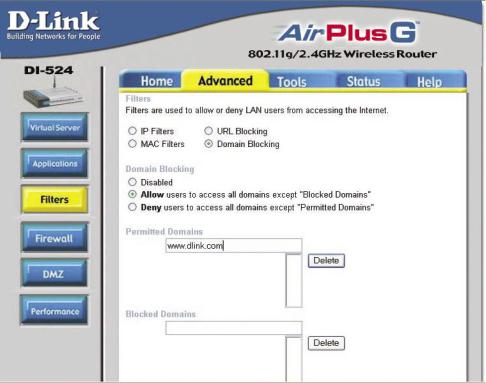
Using the Configuration Menu (continued)
Advanced > Filters > Domain Blocking
Domain Blocking is used to allow or deny LAN (Local Area Network) computers from accessing specific domains on the Internet. Domain blocking will deny all requests to a specific domain such as http and ftp. It can also allow computers to access specific
sites and deny all other sites.
Filters-
Domain Blocking-
Disabled-
Allow-
Deny-
Permitted
Domains-
Blocked Domains-
Select the filter you wish to use; in this case, Domain Blocking was chosen.
Select Disabled to disable Domain Blocking.
Allows users to access all domains except Blocked Domains.
Denies users access to all domains except
Permitted Domains.
Enter the Permitted Domains in this field.
Enter the Blocked Domains in this field.
26
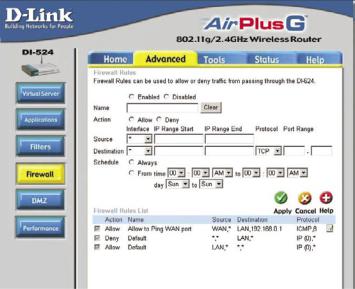
Using the Configuration Menu (continued)
Advanced > Firewall
Firewall Rules is an advanced feature used to deny or allow traffic from passing through the DI-524. It works in the same way as IP Filters with additional settings. You can create more detailed access rules for the DI-524. When virtual services are created and enabled, it will also display in Firewall Rules. Firewall Rules contain all
network firewall rules pertaining to IP (Internet Protocol).
In the Firewall Rules List at the bottom of the screen, the priorities of the rules are from top (highest priority) to bottom (lowest priority.)
Note:
The DI-524 MAC Address filtering rules have precedence over the Firewall Rules.
Firewall Rules-
Name-
Action-
Source-
Destination-
Schedule-
Enable or disable the Firewall.
Enter the name.
Allow or Deny.
Enter the IP Address range.
Enter the IP Address range, the Protocol, and the Port Range.
Select Always or enter the Time Range.
27
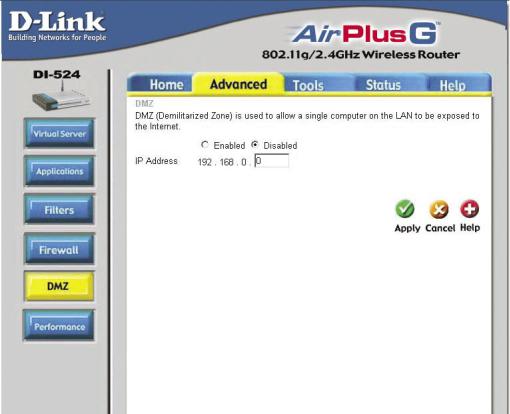
Using the Configuration Menu (continued)
Advanced > DMZ
If you have a client PC that cannot run Internet applications properly from behind the DI-524, then you can set the client up for unrestricted Internet access. It allows a computer to be exposed to the Internet. This feature is useful for gaming purposes. Enter the IP address of the internal computer that will be the DMZ host. Adding a client to the DMZ (Demilitarized Zone) may expose your local network to a variety of
security risks, so only use this option as a last resort.
DMZ-
IP Address-
Enable or Disable the DMZ. The DMZ (Demilitarized Zone) allows a single computer to be exposed to the internet. By default the DMZ is disabled.
Enter the IP Address of the computer to be in the DMZ.
28
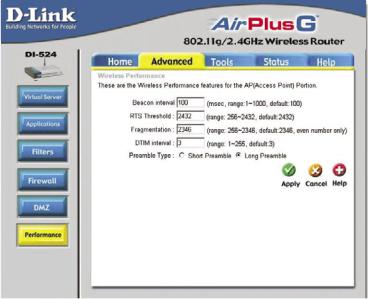
Using the Configuration Menu (continued)
Advanced > Performance
Wireless Performance-
Displayed in this windowaretheWireless Performance features for the Access Point portion of the DI-524.
Beacon Interval-
RTS Threshold-
Fragmentation-
DTIM interval-
Preamble Type-
Beacons are packets sent by an Access Point to synchronize a wireless network. Specify a value. 100 is the default setting and is recommended.
This value should remain at its default setting of 2432. If inconsistent data flow is a problem, only a minor modification should be made.
The fragmentation threshold, which is specified in bytes, determines whether packets will be fragmented. Packets exceeding the 2346 byte setting will be fragmented before transmission. 2346 is the default setting.
(Delivery Traffic Indication Message) 3 is the default setting. A DTIM is a countdown informing clients of the next window for listening to broadcast and multicast messages.
Select Short or Long Preamble. The Preamble defines the length of the CRC block (Cyclic Redundancy Check is a common technique for detecting data transmission errors) for communication between the wireless router and the roaming wireless network adapters. Auto is the default setting. Note: High network traffic areas should use the shorter preamble type.
29
